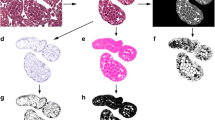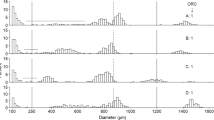Abstract
The analysis of microscopic images of fish gonad cells (oocytes) is a useful tool to estimate parameters of fish reproductive ecology and to analyze fish population dynamics. The study of oocyte dynamics is needed to understand ovary development and reproductive cycle of fish. Oocytes go through different developmental states in a continuum temporal sequence providing an interesting example of ordinal classification, which is not exploited by the current oocyte analysis software. This promising paradigm of machine learning known as ordinal classification or ordinal regression focus on classification problems where there exist a natural order between the classes, thus requiring specific methods and evaluation metrics. In this paper we compare 11 ordinal and 15 nominal state-of-the-art classifiers using oocytes of three fish species (Merluccius merluccius, Trisopterus luscus and Reinhardtius hippoglossoides). The best results are achieved by SVMOD, an ordinal decomposition method of the labelling space based on the Support Vector Machine, varying strongly with the number of states for each specie (about 95 and 80 % of accuracy with three and six states respectively). The classifiers designed specially for ordinal classification are able to capture the underlying nature of the state ordering much better than common nominal classifiers. This is demonstrated by several metrics specially designed to measure misclassification errors associated to states far in the ranking scale.



Similar content being viewed by others
Notes
References
Alfaro E, Gámez M, García N (2007) Multiclass corporate failure prediction by adaboost.m1. Int Adv Econ Res 13:301–312
Breiman L (1996) Bagging predictors. Mach Learn 24(2):123–140
Breiman L (2001) Random forests. Mach Learn 45(1):5–32
Cardoso JS, da Costa JFP (2007) Learning to classify ordinal data: the data replication method. J Mach Learn Res 8:1393–1429
Carletta J (1996) Assessing agreement on classification tasks: the kappa statistic. Comput Linguist 22(2):249–254
Chang C, Lin C (2008) LibSVM: a library for Support Vector Machines. URL: http://www.csie.ntu.edu.tw/~cjlin/libsvm
Chu W, Keerthi SS (2007) Support vector ordinal regression. Neural Comput 19:792–815
Cruz-Ramírez M, Hervás-Martínez C, Sánchez-Monedero J, Gutiérrez P (2014) Metrics to guide a multi-objective evolutionary algorithm for ordinal classification. Neurocomputing 135:21–31
Deng WY, Zheng QH, Lian S, Chen L, Wang X (2010) Ordinal extreme learning machine. Neurocomputing 74(1–3):447–456
Fernández-Delgado M, Cernadas E, Barro S, Amorim D (2014) Do we need hundreds of classifiers to solve real world classification problems? J Mach Learn Res 15:3133–3181
Frank E, Hall M (2001) A simple approach to ordinal classification. In: Proceedings of 12th European Conference on Machine Learning, pp 145–156
Freund Y, Schapire R (1996) Experiments with a new Boosting algorithm. In: International Conference on Machine Learning. Morgan Kaufmann, pp 148–156
Friedman J, Hastie T, Tibshirani R (1998) Additive logistic regression: a statistical view of boosting. Ann Stat 28:2000
Evers G (2009) An automatic regrouping mechanism to deal with stagnation in particle swarm optimization. Ph.D. thesis, The University of Texas-PanAmerican, Edinburg, TX
González-Rufino E, Carrión P, Cernadas E, Fernández-Delgado M, Domínguez-Petit R (2013) Exhaustive comparison of colour texture features and classification methods to discriminate cells categories in histological images of fish ovary. Pattern Recogn 46:2391–2407
Gutiérrez P, Pérez-Ortiz M, Fernandez-Navarro F, Sánchez-Monedero J, Hervás-Martínez C (2012) An experimental study of different ordinal regression methods and measures. In: 7th International Conference on Hybrid Artificial Intelligence Systems (HAIS), Lecture Notes in Computer Science, vol. 7209, pp 296–307
Hall M, Frank E, Holmes G, Pfahringer B, Reutemann P, Witten I (2009) The Weka data mining software: an update. SIGKDD Explor Newsl 11(1):10–18
Huang G, Zhou H, Ding X, Zhang R (2012) Extreme learning machine for regression and multiclass classification. IEEE Trans Syst Man Cybern Part B Cybern 42:513–529
Hunter JR, Macewicz BJ, Lo N, Kimbrell CA (1992) Fecundity, spawning and maturity of female Dover Sole, Microstomus pacificus, with an evaluation of assumptions and precision. Fish Bull 90:101–128
Junquera S, Román E, Morgan J, Sainza M, Ramilo G (2003) Time scale of ovarian maturation in Greenland halibut (Reinhardtius hippoglossoides, Walbaum). ICES J Mar Sci 60:767–773
Kendall M (1938) A new measure of rank correlation. Biometrika 30:81–89
Kennedy J, Gundersen A, Hoines A, Kjesbu O (2011) Greenland halibut (Reinhardtius hippoglossoides) spawn annually but successive cohorts of oocytes develop over 2 years, complicating correct assessment of maturity. Can J Fish Aquat Sci 68:201–209
Le Cessie S, Van Houwelingen J (1992) Ridge estimators in logistic regression. Appl Stat 41(1):191–201
Li L, Lin HT (2007) Ordinal regression by extended binary classification. Adv Neural Inf Process Syst 19:865–872
Lin HT, Li L (2006) Large-margin thresholded ensembles for ordinal regression: theory and practice. In: Balcázar J, Long P, Stephan F (eds) Algorithmic learning theory, vol 4264, Lecture Notes in Computer Science. Springer, Berlin, pp 319–333
McCullagh P, Nelder JA (1989) Generalized linear models. Monographs on statistics and applied probability, 2nd edn. Chapman & Hall/CRC, London
Morgan MJ, Bowering WR (1997) Temporal and geographic variation in maturity at length and age of Greenland halibut (Reinhardtius hippoglossoides) from the Canadian North-West Atlantic with implications for fisheries management. ICES J Mar Sci 54:875–885
Ojala T, Piatikäinen M, Mäenpää T (2002) Multiresolution grey-scale and rotation invariant texture classification with local binary pattern. IEEE Trans Pattern Anal Mach Intell 24(7):971–987
Pérez-Ortiz M, Gutiérrez PA, Hervás-Martínez C (2014) Projection based ensemble learning for ordinal regression. IEEE Trans Cybern 44(5):681–694
Rideout RM, Maddock DM, Burton MPM (1999) Oogenesis and the spawning pattern in Greenland halibut from the north-west Atlantic. J Fish Biol 54:196–207
Ripley BD (1996) Pattern recognition and neural networks. Cambridge University Press, Cambridge
Spearman C (1904) The proof and measurement of association between two things. Am J Psychol 15: 72–101
Sun BY, Li J, Wu DD, Zhang XM, Li WB (2010) Kernel discriminant learning for ordinal regression. IEEE Trans Knowl Data Eng 22:906–910
Waegeman W, Boullart L (2009) An ensemble of weighted support vector machines for ordinal regression. Int J Comput Syst Sci Eng 3(1):1–7
Wang N (2015) Generalized single-hidden layer feedforward networks for regression problems. IEEE Trans Neural Netw 26:1161–1176
Acknowledgments
We acknowledge support from the “Junta de Andalucía” under project P11-TIC-7508, from the Spanish Ministry of Science and Innovation (MICINN) under projects TIN2011-22935, TIN2012-32262 and TIN2014-54583-C2-1-R, and from FEDER funds
Author information
Authors and Affiliations
Corresponding author
Rights and permissions
About this article
Cite this article
Pérez-Ortiz, M., Fernández-Delgado, M., Cernadas, E. et al. On the Use of Nominal and Ordinal Classifiers for the Discrimination of States of Development in Fish Oocytes. Neural Process Lett 44, 555–570 (2016). https://doi.org/10.1007/s11063-015-9476-8
Published:
Issue Date:
DOI: https://doi.org/10.1007/s11063-015-9476-8




